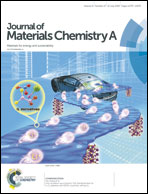Boosting the performance of organic cathodes through structure tuning†
Abstract
The decisive factor to realize high-capacity rechargeable batteries is the cathode. Since the experimental capacity of inorganic cathodes is usually less than 200 mA h g−1, searching for new cathode materials to boost the capacity is highly desirable. Here, we design and synthesize two novel organic cathodes, poly(pyrene-4,5,9,10-tetraone) (PPTO) and poly(2,7-ethynylpyrene-4,5,9,10-tetraone) (PEPTO), based on the highly redox-active pyrene-4,5,9,10-tetraone. Due to their four Li+ ion intake characteristics, both cathodes show a large reversible capacity of 234 & 244 mA h g−1 and a high energy density of up to 530 & 507 W h kg−1, respectively. In particular, benefiting from the enhanced conjugation and planarity, PEPTO with the addition of a carbon–carbon triple bond (C![[triple bond, length as m-dash]](https://www.rsc.org/images/entities/char_e002.gif) C) delivers a significantly improved rate stability at high current densities and an excellent capacity retention of 110 mA h g−1 after 1000 cycles (at 800 mA g−1). Our approach could provide an effective strategy to prepare new organic cathodes for the next generation of high stability and high energy density organic batteries through structure tuning.
C) delivers a significantly improved rate stability at high current densities and an excellent capacity retention of 110 mA h g−1 after 1000 cycles (at 800 mA g−1). Our approach could provide an effective strategy to prepare new organic cathodes for the next generation of high stability and high energy density organic batteries through structure tuning.



 Please wait while we load your content...
Please wait while we load your content...